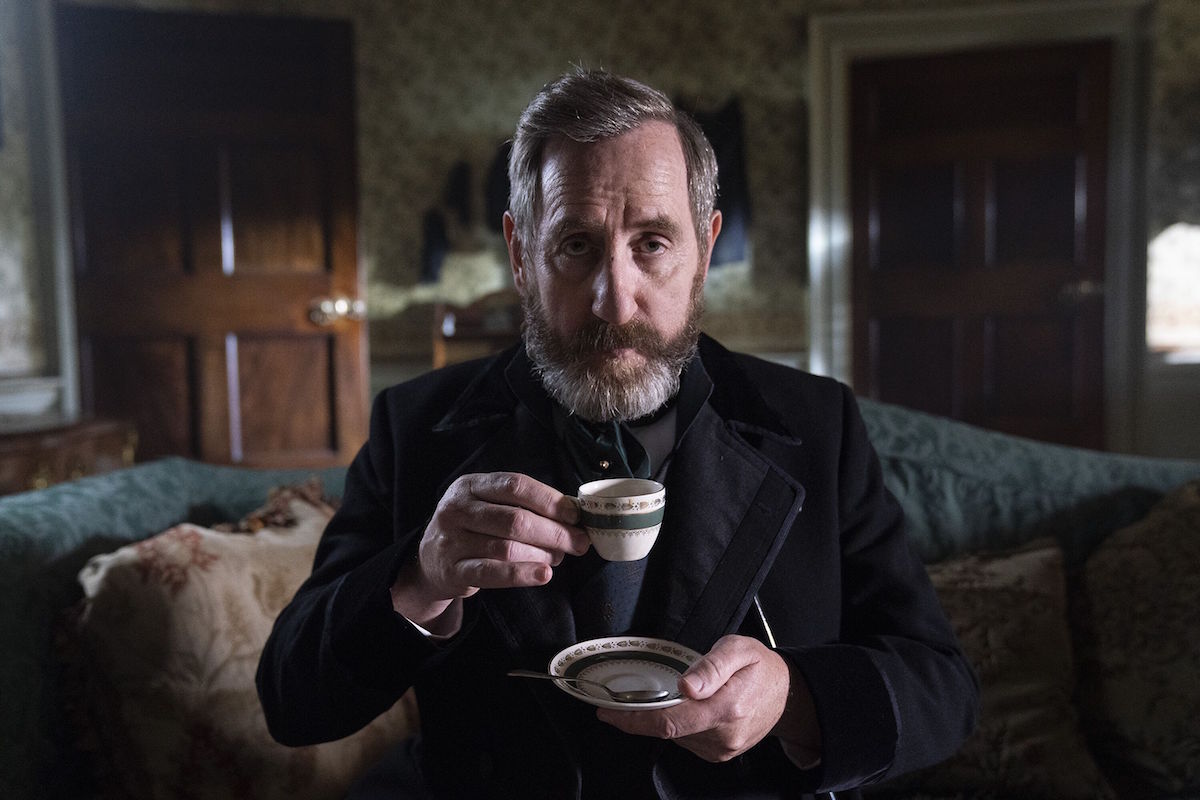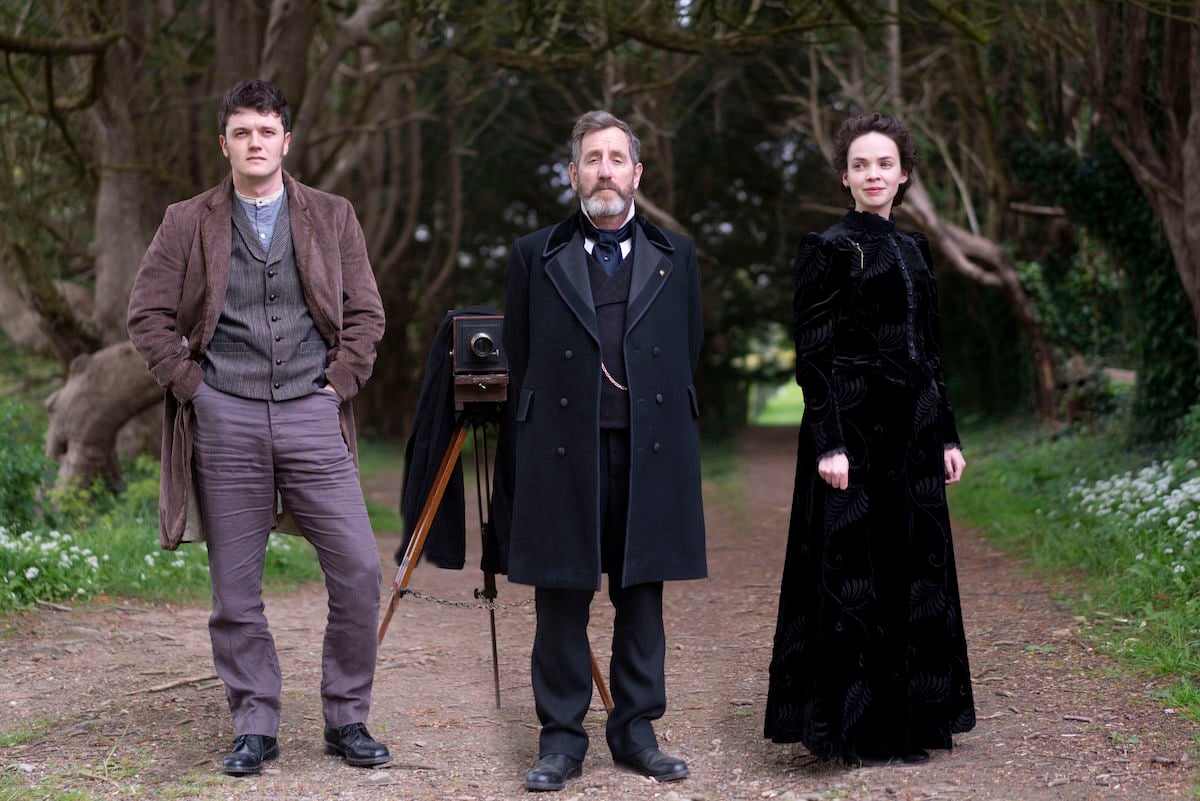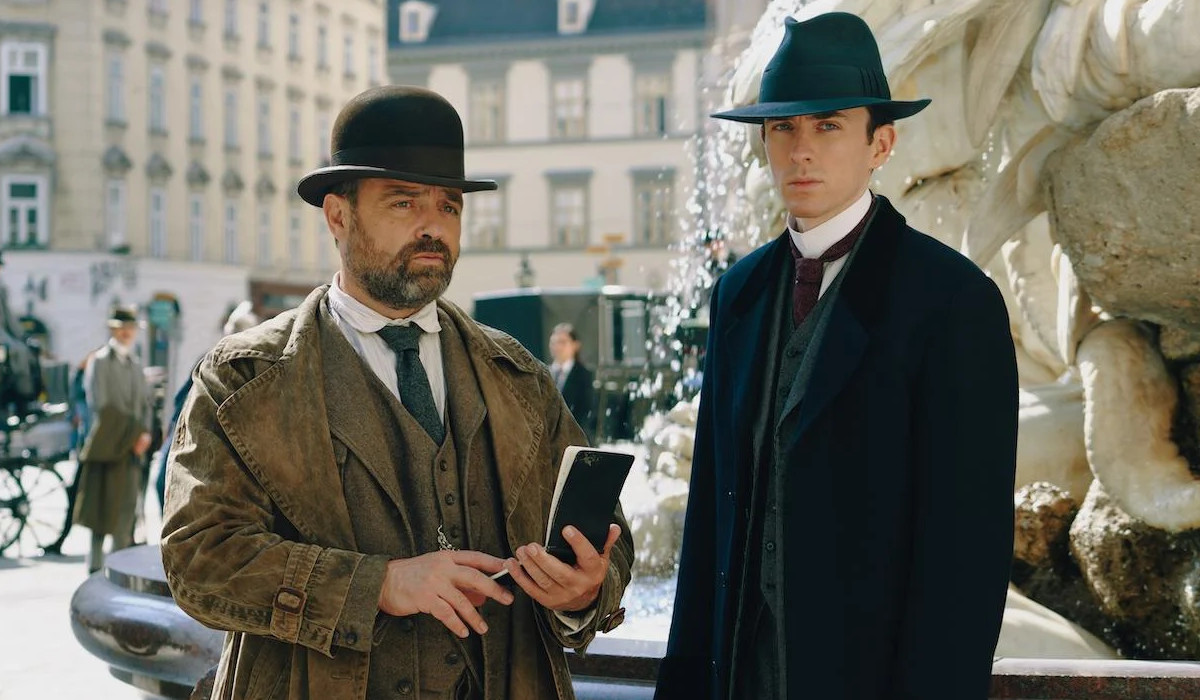Dead Still centers around a practice many of us would view as odd—the Victorian tradition of mortuary photography. That’s taking a snap of a dead person, either on their own or posed with their family. The show follows a celebrated mortuary photographer who is dragged unwittingly into a murder mystery that hits close to home, and balances on a fine line of comedic sensibility against a morbid backdrop.
The six-episode first season of Dead Still, which premieres on Acorn TV on May 18th, is set in 1880s Dublin. Actor Michael Smiley, who is always excellent, is in rare form as the fussy, aristocratic Brock Blennerhassett, a pioneer in the field of mortuary photography. That is, no one takes such artful, “lively” photos of the dead. He’s assisted by his free-spirited niece Nancy Vickers (Eileen O’Higgins), and the stalwart, soulful Conall Molloy (Kerr Logan), an ex-gravedigger who aspires to become a photographer himself.
While the emotionally distant Blennerhassett wants to stay in his lavish, insular world, Detective Frederick Regan (Aidan O’Hare), a sort of blundering visionary with a nose for crime, draws him into an investigation of macabre deaths around Dublin. Regan, who is obsessed with busting up the new black markets for “obscene” photography, is pursuing the idea that someone is staging and photographing murders in a style eerily like Blennerhassett’s.
Dead Still is unique not just in its subject matter—which zooms in on practices of grieving that can feel profoundly alien to a modern audience—but in its co-mingling of dark humor, ghastly pastimes, and tongue-in-cheek period representation. The tension between characters often emerges from class differences, and it’s interesting to watch how that plays out amongst a distinctly Irish population.
Too often in period dramas, an Irish character will be stereotyped or secondary, but here Ireland, and its internal divisions and political conflicts, are in focus. Sometimes the temperature of society will be taken with a passing comment, and sometimes raised eyebrows are all that’s needed. There’s a fantastic bit where the privileged, naive Nancy, a would-be actress, gussies herself up to infiltrate a working-class neighborhood, but she’s a painfully transparent figure to the world-weary denizens of those parts who encounter her.
Victorian Dublin is not a setting I’ve seen represented often before on television, and it also makes for an intriguing jumping-off point. The show does a nice job of showcasing an era that was equal parts repressed, decadent, sensationalist, depraved, and prim—and one that was absolutely consumed with the rituals of death. On the whole, Victorian mourning practices were ornate, time-consuming, and intense by modern-day standards.
The etiquette and expectations were extensive across classes, with many standards set by Queen Victoria herself, who was devastated by the death of her husband Albert in 1861. While mourning-wear was often elaborate and strictly dictated (especially for women), it’s traditions like post-mortem photography and jewelry and mementos made of loved ones’ hair that have held a fascination for some of us for well over a century.
Photographs of the dead weren’t only the province of the wealthy, being more economically accessible than paintings, and in many cases would have been the only picture ever taken of a beloved subject. As Professor Mary Warner Marien wrote, grieving people turned to the practice so that they might “capture an image of a deceased loved one rather than have no photograph at all.” It’s hard for us to imagine as we carry around phones with thousands of pictures on them, but even a single exposure was precious.

Series co-creator (with Imogen Murphy) and writer John Morton seems to have been equally captivated by the photography aspect, telling period drama site Willow and Thatch, “It’s a very morbid concept, almost comically so at times, looking at the lengths people would go to in order to make a loved one look alive for a photograph. But there’s also something quite poignant about it.” It’s death as a central conceit of the show, coupled with gallows humor, that makes Dead Still tick along like the fine pocket-watches borne by the characters, whose chains and fobs are gleamingly displayed.
Dead Still is worth it to period drama fans for the gorgeous costumes and rich sets alone, and those who might not normally watch murder mysteries may find the comedic elements appealing, as they provide levity to an environment that harbors a vicious killer. It can verge at times on the slapstick and totally absurd, but we’re always grounded by engaging performances.
There are also winking plays on popular entertainment of the day, like Gothic novels—which got a significant boost by the Irish Victorian writers Sheridan Le Fanu and Bram Stoker—in a half-scary, half-hilarious episode where Blennerhassett and Molloy must stay over at a possibly haunted manor-house, and the Victorian preoccupation with seances, in perhaps the most off-the-rails seance sequence you will see on television. The show also has a rather modern sensibility despite its trappings, so those who aren’t necessarily drawn to period pieces will also find fun here.
For me, what made Dead Still so compelling to watch was its offbeat themes and the strength of its characters. Its arrival is also well-timed for our current circumstances. Most of us experience death these days as a distant, sterilized affair, and now we see it as frightening numbers on the news. But it used to be something that took place in homes, and, though tragically more commonplace—especially amongst babies and children—it could be embraced, understood, and made accessible at in a way denied to us today.
Mourning as the Victorians went about it provided a closeness to the deceased that may seem odd to us, but feels doubly poignant in a time when even funerals must be held on video conferences and burials are socially distanced. And while the characters’ concerns about technology are quaint—the obscene and disturbing pictures people are dealing under the table in Dead Still are available now in multitudes with the click of a button—its emphasis on the ramifications of technology being used for both good and, well, evil have never been more applicable than now.

This series really belongs to the actors and their characters. I may have guessed at the murderer pretty early on, but by God did I want to see how it would be played out. Smiley, a Northern Irish actor and comedian who has embodied a range of roles across every genre, is just astonishingly good as Blennerhassett. At first an insufferable snob, before long it’s impossible not to like the intrepid photographer, though I wish the show did more with its implications about his sexuality (if there’s a season 2, the set-up is that it might).
Logan’s Molloy is the strapping, soft heart of the piece, and O’Higgins’s independent Nancy refuses to be hemmed in by the expectations of her age (and her eccentric family, which must be met to be believed). I also adored Aoife Duffin as Detective Regan’s clever wife Betty; she’s clearly the brains of the operation, and if this were set a hundred years later, she’d be the one out solving crimes. In fact, all of the women on Dead Still are strong and smart, another element that is quite refreshing to see on television, let alone a period drama.
Dead Still is a particularly good diversion at this moment in time: it transports us to a different era, gives us plenty of pretty—and pretty strange—things to gaze upon at, and makes us laugh when we need it most. After seeing it through Brock Blennerhassett’s lens, you might never look at death in the same way again.
(images: Acorn TV)
Dead Still premiers May 18th, 2020 on Acorn TV’s streaming network, which hosts select British, Irish, Canadian, Australian, and other international content. It is the only channel that I watch now. You can sign up for a free 30-day trial using the code FREE30 at http://acorn.tv.
Want more stories like this? Become a subscriber and support the site!
—The Mary Sue has a strict comment policy that forbids, but is not limited to, personal insults toward anyone, hate speech, and trolling.—










Published: May 15, 2020 04:42 pm